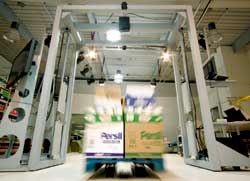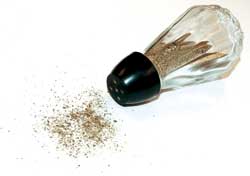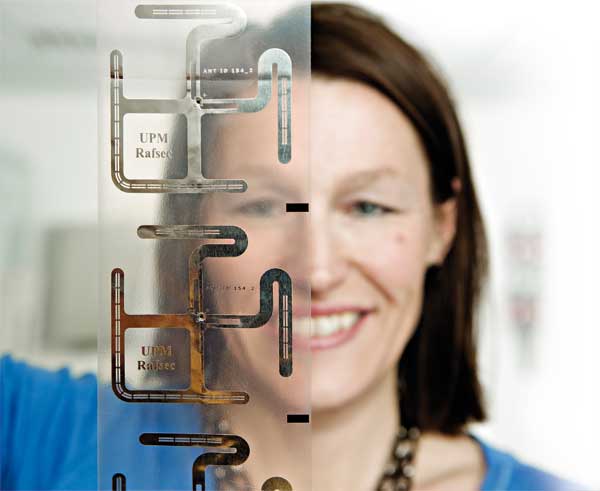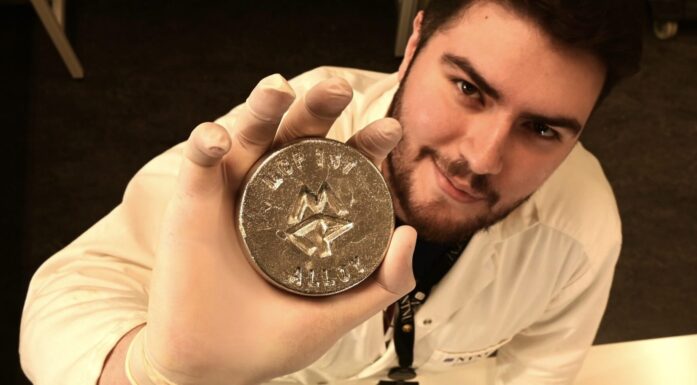On track – talking back
Small chips tell you where goods are, and if they are in good shape.
Imagine a world in which everything that you own is numbered and catalogued. All your shoes; every piece of clothing. A world in which nothing can be regarded as private, but where everything can be traced back to you. Take a step further in your thinking and you have a universe in which every movement is also registered. How many times did you go to the off-licence last month, and how many litres of milk did you buy last Saturday?
This situation is not far off, if we can believe Kathrine Albrecht, one of the USA’s leading experts on personal data protection. She is among those who are suspicious of the potential applications of identifying individuals with the aid of the new technology known as RFID – Radio Frequency IDentification.
One American company has already developed a chip that can be implanted in your arm. This could assign each of us a unique ID number linked to information in a central database. Quite unacceptable, according to Albrecht.
However, such critical voices are few and far between. Most people are likely to think that RFID is primarily an identification technology that is tailor-made for industries that depend on supplies of services, flows of materials, stocks of goods, manufacturing and reliability of supply. And that the potential for improved efficiency and security exceeds our imagination.
Readable numerical codes
Let us take a look at what the technology is all about. For the sake of simplicity we can start with the bar code that we all know from everyday shopping, the code that is scanned and turns into an amount when we get to the check-out.

With RFID we can drive a whole container through a warehouse door and read off all its contents simultaneously.
Photo: © Informationsforum RFID, 2007
RFID technology is similar, but it goes further. The bar code is replaced by a readable numerical code and is loaded into a radio chip. The code can be made as long as we want, and can thus hold as much information as is needed. If there is a reader within range that can receive the radio signal, the unique ID will be read. One more thing: the chip can be placed inside a product so that it is invisible to the naked eye, and you can add on a couple of sensors that offer extra functions.
This technology is already in use – in key-cards, highway toll chips, tracing packages during transport – and exposing shoplifters. What is new is the prediction that RFID is about to conquer the world. It will sweep over us like a whirlwind and leave us slightly confused in a landscape quite different from what we are used to.
RFID technology is already used in the access cards we use at work and the toll chips in our cars, but this is just the beginning, say the same experts. In 2007, 1.7 billion chips were sold at a total cost of NOK 33.1 billion. According to EU Commissioner Vivianne Reding, 450 billion chips will be produced within ten years.
Safe food
At SINTEF, senior scientist Professor Heidi Dreyer talks enthusiastically about the chip, She sees great potential in manufacturing and goods flow, health and transport. For example, RFID can replace many boring manual tasks.
Dreyer works in logistics, on how we can use technology to control goods manufacture. For her, concepts such as coordination, environmental benefits, efficiency and control are neither woolly or abstract. On the contrary, solid knowledge is linked with goods that are constantly in transit.
Dreyer speaks of the NOK 24 million project called “Smart flow of goods”, in which compan-
ies in the Norwegian food sector have joined forces to develop intelligent packaging with RFID chips that will incorporate sensors. The project is being supported by the Research Council of Norway’s BiA Programme.
Does she not envisage any dangers?
“Yes, but isn’t that true of all new technology? It has quite obvious advantages, but is absolutely capable of being misused”, she believes. “We simply need to find systems that can take personal data protection and security into account.”
“And where flow of goods is concerned the advantages are probably more important?”
“Absolutely. Food security is becoming more and more important, and through RFID, the food of the future, as it is popularly known, will be able to tell us where it has been and whether it is in good condition, for example via sensors for pressure, temperature and movement. Foodstuffs will also be able to tell us how conditions were on the way to the store shelf”, says Dreyer, citing the 2005 Food Act which requires all food products to be traceable.
Advantages
“OK. But as a consumer, what advantages will I notice, and what will be the advantages to the manufacturer, supplier and wholesaler when RFID arrives in the shops?”
“Consumers will probably not notice so much”, says Bård Myhre at SINTEF ICT. “You will be less likely to leave the shop with food that has passed its sell-by date, or is close to it. And then, you can also get a lot of information about products”, he adds.

RFID chips have become so small that you would find it difficult to distinguish one from a peppercorn.
Foto: Raymond Nilsson
“For example, how about being able to dazzle your guest on a Saturday evening by telling them that the meat they are going to eat tonight came from Tverråflåten Farm by the Sognefjord, where the sheep, which have been carrying GPS units all summer, have been grazing in the luscious green meadows in the valley above the fjord.”
Producers will enjoy greater advantages in that their products can be traced back to the source. A company such as Nortura cannot risk many food-safety scandals in the course of a year. An E. coli scandal in 2006, when sausages were responsible for the death of one child and made 14 other children seriously ill, was also a hard blow to the company’s reputation, and must not be allowed to happen again.
Goods in transit
Heidi Dreyer focuses on how she can help goods manufacturers to keep an eye on where their products are at any given moment. What is the status of stocks? What is being sold most and least? What has the shopkeeper received today from his dairy and meat wholesalers? Which products they ought to order less of next week?
“The real benefit of RFID is improved visibility”, says Dreyer, “that the value chain from wholesaler to supplier to customer is as transparent as possible. Having a good overview is a competitive advantage.”
“How so?”
“Today you have to guess which products are in demand and which need to be manufactured and warehoused. RFID can give you an oversight over real needs, so that you can speed up production when demand is high; all in all, you can rapidly adapt yourself to the market. The results will be fresher goods for the customer.”
In such cases, recording goods is essential. Dreyer draws us a picture of a stressed shop employee who is reluctantly taking in today’s delivery of stock. Perhaps the food will have to be set aside because the store is too busy to record it. Perhaps it will be recorded carefully by checking off milk, yogurt, kefir, cream and crème fraiche on the bill of lading. Some shops have scanners that can be run on individual cartons.
“With RFID, you can wheel the whole container from the dairy company through a gate and read off everything at once”, says Dreyer.
Stores of the future
The Metro Group supermarket chain, with its 240,000 employees in 28 countries, is among the first companies in the world to plan to make major investments in RFID.
The company has analysed the results of trials, and has concluded that RFID will offer major efficiency improvements, while shoplifting will decrease, and the availability of its product range will substantially increase.
However, there is still a long way to go before every single item will be fitted with a chip. In the first instance, it is most relevant for cases and pallets. The Metro Group estimates that it will be at least ten years before every individual item is marked with an RFID chip.
Controlling materials flow
All sectors of industry that would like to have better control of their materials know that the alpha and omega of this ambition is to link information directly to the raw material. This enables the information to follow the product through the entire value chain.
The forestry industry’s raw materials are spread over huge geographical areas, and tracing, steering and controlling these materials through the chain involve major challenges. If every single log could be identified via RFID technology, information about its origin, volume, quality, felling date, etc., could accompany it from where it grew, to the loading site and all the way to the sawmill. Skogdata and Skogforsk are therefore in the process of testing RFID technology on a value chain in the forestry sector.
DID YOU KNOW THIS ABOUT RFID?
• Hitachi has recently produced the smallest RFID chip in the world; it is about an eighth of the thickness of a human hair.
• On Cebit’s website, 60 per cent of survey respondents say that they know too little about RFID to be able to evaluate the advantages and disadvantages of the technology, while 67 per cent consider that it brings up personal data protection issues and 55 per cent want to see the use of the technology regulated.
• The adhesive label itself is unintelligent and only contains a digital code that can be recognized by the system. The most important part of the system is the network service that keeps track of the system and can trigger a response when a specific RFID chip is read.
• A starter kit consisting of a reader and ten labels costs €35 on the Internet. The labels are compatible with the new NFC standard that is about to reach our mobile phones, so that all we need to do is hold the mobile close to the chip to launch a service. For example, a home help aide can hold her mobile against a label on the front door of an elderly couple and log herself in and out, and receive any information they might need, direct to her phone.
The Norwegian Ultra grocery chain is currently testing the technology in its stores. Norplasta, Nortura and the Petersen paper packaging company are drawing up plans for a joint test, while the Akro wholesale company is testing how RFID can be used to read goods in and out of its warehouses.
Another electronic revolution is expected on the Norwegian continental shelf: a project group made up of SINTEF, the Norwegian Oil Industry Association and the largest North Sea operators want all containers, lengths of drill-pipe and other types of fixed offshore equipment to be marked with chips.
ConocoPhillips is among the companies most likely to adopt a pilot study of this sort, since it already has some experience of such monitoring offshore. Among other measures, the company has fitted its Ekofisk personnel with RFID necklaces, so that they can be recorded in the event of accidents or other incidents. Millions of the products that surround us in our everyday life will finally be tamed, classified and directed.
Challenges
Although most of the technology involved is already well developed, the most important challenge is the cost, while another is the lack of definitive standards. Nor is this a matter of simply purchasing a system and bringing it into use; RFID requires resources such as in-house competence and expertise. For this reason, not many Norwegian companies have adopted the system on a small scale, apart from Nortura, Bama and Tine, which have gone on the offensive in order to remain competitive. Gilde, in the Nortura group, uses RFID internally in two of its plants to guide cases of parts directly to their production lines.
“Great expectations, then, but also major obstacles?”
“Yes; Norwegian companies need to build up their competence”, says Dreyer. “Many are just sitting on the fence and waiting to see what happens. If the system is to function well, products will also have to be standardized and given unique identities that all users can understand.”
“In reality, the current bar code system will probably remain in use for several years yet”, says Myhre, “but certain aspects of the code have weaknesses, and this is where RFID can be useful. For example, the new technology allows information to be read through layers of wrappings and packaging, and many chips can be read simultaneously.
Myhre also points out that Norway has technological advantages.
“SINTEF is Norway’s powerhouse in RFID research, with researchers working on the marine environment, ICT, logistics and transport. For instance, we have been involved in the development of technology for RFID chips with integrated sensors. Trondheim also has a company called Matiq that has gone in for this technology.”
It is therefore likely that Norway will experience an increase in the use of RFID within the next few years in such sectors as transport, manufacturing and trade.
“The most important question in the future, therefore, is likely to be not WHETHER we will adopt this technology, but HOW we can best exploit it”, says Myhre.
Åse Dragland





